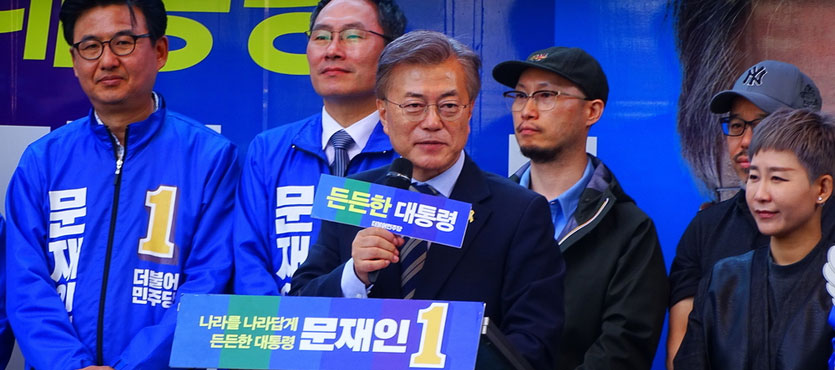Seoul and Pyongyang suddenly seem poised to end some 60 years of hostilities. What does this development mean for military contractors in South Korea and Japan?
During an April 2018 summit meeting, North Korean strongman Kim Jong Un and South Korean President Moon Jae-in apparently reached agreement in principle for a permanent peace treaty and the dismantling of nuclear weapons. President Moon deflected talk that he should receive the Nobel Peace Prize for his efforts. “It’s President Trump who should receive the Nobel Prize. We only need to take peace,” he said during a Cabinet meeting. The White House agreed in part, opining that the U.S.-led sanctions against North Korea created enough pressure to force the reclusive Communist government to the negotiating table.
Seoul will apparently take an active role in the upcoming summit meeting between Kim and President Donald Trump. In that same meeting, President Moon said he hoped to “operate the trilateral channel for dialogue between the North and the U.S.”
The Two Koreas
In late 2017, it appeared that the war of words among the United States, North Korea, and South Korea might lead to the most destructive war in history. But then the mystical Olympic Spirit intervened. Both Koreas marched together in the opening ceremony. During the Games, North and South Korea fielded a joint women’s ice hockey team.
Usually, the goodwill at these games only amounts to a few weeks of burying the hatchet, but this time, the rapprochement was genuine. In April 2018, the two leaders met during a historic moment. The subsequent meeting may have generated a blueprint for long-term peace.
Since a ceasefire ended the Korean War in 1953, the United States Eighth Army has been in South Korea to deter further Communist aggression. China may still present a looming threat in the region. However, if the Korean Peninsula unites, many will loudly call for the removal of most U.S. troops.
U.S. Forces in South Korea
A former commanding general once remarked that the “Eighth Army arrived in July 1950 and never left.” The Eighth Army was rushed from occupation duty in Japan to Korea when the North Koreans invaded in June 1950. The lead elements were ill-prepared, and the Eighth Army was pushed back to the Pusan Perimeter in the extreme southeast. The Eighth Army gathered itself, broke out, and advanced all the way to North Korea’s border with China. After the Red Army attacked, the Americans and their allies once again fell back in disarray.
After the front stabilized and two years of ceasefire negotiations finally bore fruit, the Eighth Army remained behind. For a time, the 2nd Infantry Division was stationed right along the border and guarded it with tactical nuclear weapons.
In 2004, the U.S. and South Korea agreed to move the bulk of forces to Camp Humphreys, which is south of the Han River. Camp Humphreys is about twice as far from the border as the previous barracks at Yongsan Garrison. The move was clearly intended to reduce tensions in the area. Although it took a lot longer than hoped, that move may have paid off.
LTG Michael A. Bills, the Eighth Army’s CO, is in charge of all American and South Korean forces on the peninsula.
What Contractors do in Japan and Korea
Over the past few years, most Eighth Army contractors have been working on the sprawling Camp Humphreys. It includes several schools, including a high school designed to accommodate 1,700 students, as well as all necessary athletic fields and other facilities. The kids probably enjoy the Splish-n-Splash water park a lot more than they enjoy the schools. There is also a mid-size hospital and a 72,000-square foot PX.
With a base the size of Camp Humphreys, there are many other logistical tasks. The Army handles many of these duties, but contractors handle many others. These jobs include:
- Cooks,
- Nurses,
- Mechanics,
- IT workers, and
- Longshoremen.
If peace does come to Korea, the Eighth Army may relocate off the Peninsula. Or, at least much of the force may move. If that happens, contractors will most likely be there to provide construction and logistical services.
Compensation for Injured Contractors
In Korea or Kalamazoo, construction is dangerous work. It is consistently rated as one of the most dangerous industries in the world. According to the Occupational Safety and Health Administration, most construction-related fatalities are due to the “Fatal Four” of:
- Falls,
- Electrocutions,
- Caught-between, and
- Struck-by.
Compensation is available for all these injuries under the Defense Base Act. Thankfully, Korea is not an active war zone. If North and South do conclude a peace treaty, some people may not consider the Peninsula to be a war zone at all. But for DBA purposes, Korea is and will be a war zone. The U.S. military has at least one facility in-country, which makes it a war zone in this context. That facility could be something as big as Camp Humphreys or something as small as a military attache.
For more information about the benefits available to injured contractors, contact Barnett, Lerner, Karsen & Frankel, P.A.

